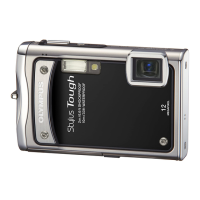IThe picture is too grainy
There
are
several
factors
that
can
cause
the
picture
to
appear
grainy.
Using the digital zoom to take close-up pictures
• With the digital zoom, part
of
the image is cropped and enlarged. The greater the
magnification, the grainier the picture appears.
~
"DIGITAL
ZOOM
Zooming in on
your
subject" (P.27)
Increasing the ISO sensitivity
• When
you
increase the [ISO] setting, "noise",
which
appears
as
spots of unwanted color
or
unevenness
in
the color,
can
be
introduced
and
give
the
picture a grainy appearance. This camera
is
equipped
with
a function
to
allow shooting at
high
sensitivity while suppressing
noise;
however,
increasing the
ISO
sensitivity
can
result
in
some
noise,
depending
on
the shooting conditions.
~
"ISO Changing the ISO sensitivity" (P.26)
Taking pictures with the correct color
•
The
reason
why there
are
sometimes differences between
the
actual colors
and
the
colors recorded
in
a picture
is
related
to
the
light source illuminating
the
subject.
[WB]
is
the
function that helps
the
camera determine
the
true colors. Normally,
the
[AUTO] setting provides
the
optimal white balance,
but
depending
on
the
subject, results may
be
better if
you
manually adjust
the
[WB]
setting.
• When the subject is in the shade on a sunny
day
• When the subject
is
illuminated by both natural light and indoor lighting, such as
when near a window
• When there is no white in the center
of
the frame
~
"WB Adjusting the color
of
a picture" (P.26)
Taking pictures
of
a white beach or snow scene
• Take pictures with
[J~
in
SCN mode. Suitable for taking pictures on a sunny day at the
beach
or
in the snow.
~
"SCN (Scene) Selecting a scene
mode
according to the shooting situation" (P.25)
• Often, bright subjects (such as snow) turn out darker than their natural colors. Use
6~
to adjust toward [+] makes the subject brighter. Conversely, when you are shooting dark
subjects, it can be effective to adjust toward the [-]. Sometimes, using the flash may not
produce the brightness (exposure) that
was
intended.
~
"6
~
button Changing picture brightness (Exposure Compensation)" (P.17)
Misalignment
of
panoramic pictures
• Panning along the camera central axis reduces picture misalignment. When you shoot
close subjects, panning along the axis
of
the tip of the lens gives good results.
• In [COMBINE IN
CAMERA
1] mode, the camera automatically detects its own position
except for the following cases (In such cases, use [COMBINE
IN
CAMERA
2]
or
[COMBINE
IN
PC].) :
• when panning the camera in a quick
or
unsteadily manner.
• when shooting a
low
contrast subject (blue sky, etc.).
• when shooting a moving subject framed in full screen.
• when panning the camera with no images on-screen.
Taking pictures
of
a subject against backlight
When
Shadow Adjustment Technology
is
set
to
[ON],
the subject's face appears brighter even
against backlight
and
the color of the background
is
enhanced
in
the picture. This function
can
also
be
used
to
shoot a subject inside a home or building from outside.
"fit Brightening the subject against backlight" (P.18)
With
[ESP/[!]]
set to
[0],
the picture can be taken based on the brightness at the center
of
the monitor without being affected by the light in the background.
"ESP/[!]
Changing the area for measuring the brightness
of
a subject" (P.28)
Set the flash to
[~]
to activate fill-in-flash. You can shoot a subject against backlight
without the face
of
the subject appearing dark.
[~]
is effective for shooting against
backlight and under fluorescent and other artificial lighting.
,,[)~
button Flash shooting" (P.17)
.....
o
;A
:::J
o
~
'<
o
c
....,
()
Q)
3
CD
....,
Q)
0-
CD
.....
.....
CD
....,

